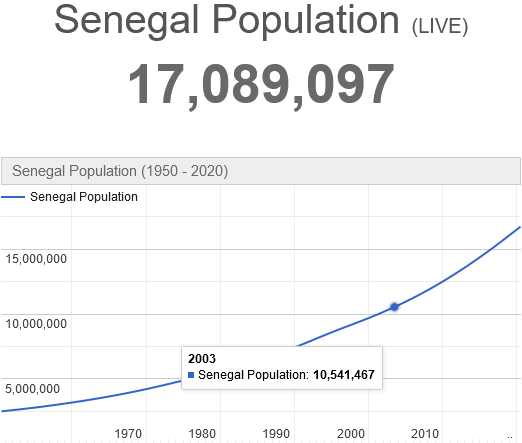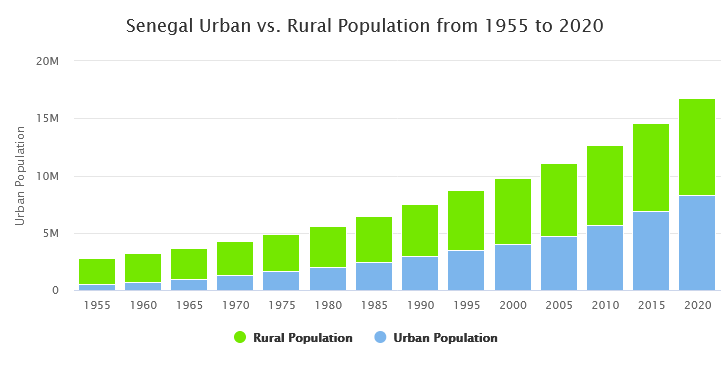As per current projections, the population of Senegal is projected to increase for the remainder of the century. With a population of 17,084,661 by 2021 (illustrated in figure 1), Worldometer (2021) equates this number to 0.21% of the total global community (Alobo & Bignebat, 2017). With the current regional population, Senegal ranks 72nd when compared to the other countries across the globe (Sendra Fernandez, 2020). Notably, Senegal comprises multiethnic inhabitants distributed throughout the country. Specifically, Whereas Wolof makes about 37.1% of the population, the other groups consist of Pulsar 26.2%, Serer 17%, Mandinka 5.6%, Jola 4.5%, and Soninke 1.4%, the remaining 8.3% comprising of the individuals of Lebanese and European descent (Durrani & Crossouard, 2020). Although every tribe has its unique language, French is the official language used by the people within the jurisdiction. Notably, analysts expect the country’s population to increase before the end of this century.

Senegal has a population density of 87 square kilometers, equating to 225 persons per square meter. Roughly 42% of the population of Senegal lives in the rural area. The population size of rural communities varies from approximately 77 per km2 in the West-central to 7.2 per km2 mostly in Arid East (Sinatti, 2019). The country’s population density is 68 persons per square km (Newman, 2019). Senegal is a country in West Africa located on the westernmost part of the continent. Senegal is known as the ‘Africa Gateway’ and is served by multiple air and sea routes. This African country has a multicultural area endowed with animals and plant life (Alobo & Bignebat, 2017). It is located on a biodiversity border with the quasi grassland, the beachfront, and tropical rainforests. The nation’s cultural heritage was chosen from this beautiful biological heritage: the baobab plant and the lion.
With the argument that over 17 million are distributed all over the country, Dakar is a city with the largest population (2,476,400), followed by Pikine (874,062), then Touba (529,176). Also, Thies (320,000) and Thies Nones (252,320) are the other towns with the significant number of people residing therein (Lavenex et al., 2016). In this country, the natural increase rate was 27.94 people per thousand people by 2020; this represents a 1.48% decrease from 28,36 people per thousand populations last year (Newman, 2019). With the country’s population’s 2.25% growth rates, the current population will double after twenty-nine years should the conditions remain unchanged. Based on its growth rate, Senegal ranks 33rd when compared to the world’s countries (Durrani & Crossouard, 2020). The life expectancy of Senegal is 68.87 years, with each gender having different rates. For instance, whereas the females have a life expectancy of 70.9 years, males recorded about 66.6 years.

As per the World Bank’s collection of development index compiled from officially-recognized sources, the age-dependence ratio (percent of the working population) was 84.97 percent in 2019. Senegal – Dependency ratio of age (percentage of working-age population) – the World Bank in March 2021 provided accurate figures, historical figures, and projections. The balance of dependence is between people under 15 years of age and the working-age population under 64 years of age, between 15-64 years. The data show the fraction of employees per 100 population of the working period (Lavenex et al., 2016). The literacy rate for adults is the number of people aged 15 years and over who can both study and write a short, factual comment about their daily lives. A Senegalese worker generally earns approximately 350,000 XOF every month. According to Sendra Fernandez (2020), the pay ranges from the lowest overall of 88,600 XOF to 1,560,000 XOF. His record is the monthly wage, including housing, transportation, and other benefits.
In determining salary, the level of experience is the most significant factor. Overall, employees with two or five years’ expertise typically earn 32 percent more in all sectors and fields than newcomers and juniors. Professionals with more than five years’ experience generally make an average of 36% than those with five years or less (Durrani & Crossouard, 2020). When people reach the 10-year mark, wages increase by 21 percent for those who have passed the 15-year mark (Sendra Fernandez, 2020). Unfortunately, reports indicate that high malfeasance with improper justice, extremely slow governmental formality, and a failing educational system are among the most significant barriers to the nation’s economic development. Based on the demographic transition model, Senegal records a reduced fertility rate.
Senegalese’s pattern matches the trend in certain northern African nations more closely, though not precisely, in the first stage of their fertility decreases. Although we cannot know Senegal’s population, a comparison between Senegal and another country in its demographic shift may reveal what is ahead (Newman, 2019). As Senegal seems to be more like the changes in northern Africa than the differences in sub-Saharan Africa, it can also be usefully compared with an Africa north as its emerging fertility changes are similar.
Although Senegalese during the previous centuries upheld the pro-natalist types of population policy, the new governments recommend an anti-natalist approach. Also known to us as “natalism,” are countries that encourage reproductive activity. Countries promoting naturalism are like Germany. Natalism methods, usually implemented by governments, promote and glorify parenthood by encouraging them to pay the first year of their life. They also try to reduce abortions and to make it easier to have a child and occur collectively. Because old societies believe women are both unable to work and parents, the administration attempts to foster this contrasting belief. On the other hand, anti-natalism, which restricts the country’s population, is the antithesis of birtherism (Sinatti, 2019). Compared to other policies, their methods of anti-natalism are regarded as very stringent. Many LEDCs have this kind of policy to balance their addiction ratios.
Lack of enough resources to facilitate the well-being and sustainable existence of Senegal people is vital. Senegal is recognized as a source of migration, as in many sub-Saharan African countries. In 2013, 1881603 internal immigrants, comparable to 14.6 percent of the total population, came from Senegal, 13 million with the number of people in this country was 586870 in 2015 (Maarel, 2019). The forecasted proportion of Senegal’s urban population is projected to rise from 44% by 2015 to 55% by 2040, above average in sub-Saharan Africa (Lavenex et al., 2016). The rural population migrates to cities and larger agglomerations, predominantly rural young people, because of low productivity and poor rural areas’ salaries. Significantly, Figure 2 gives an illustration of the rural-urban migration in Senegal between 1955 and 2020.
Senegal has an advantage over Sub-Saharan Africa, with nearly half its populace. The urban population in Senegal has almost doubled in recent decades from 23 percent during 1960 to 43 percent in 2013, with the prediction that it could reach 60 percent by 2030 (Sendra Fernandez, 2020). This growth presents enormous challenges, but it also offers Senegalese politicians the opportunity to change the Senegalese economic growth architecturally. 65% of the West African country’s gross domestic product of west African country is manufactured in urban areas and 50% in Dakar itself (Fredericks, 2018). Thus, most city areas, such as Dakar, the Senegalese capital, have driven urban development.
Specific push and pull factors determine migration among Senegalese, hence the need to evaluate them. Whereas pull factors are those in the new destination that attract people or groups to leave home, push elements to propel people willingly. The migrants are often forced to do so because they could be at risk if they do not relocate. For instance, poor education quality is one-factor motivating Senegalese scholars to relocate to other countries. Photocopiers provide more items than databases can, with findings, it is not unusual to fight for scant publications at Ethiopian universities (Lavenex et al., 2016). Web laboratories and cafes, private products that come forth like mushrooms, and pronunciation redemption for accomplished scientists do not bridge the knowledge gap.
Advancing industrialization in the urban centers contributed to the rural-urban migration. By 2020, the urban population was 48.1% indicating that the urbanization rate is 3.73% annually (Maarel, 2019). For instance, Dakar recorded about 3.140 million people. According to statistical survey data in two rural communities of Kaolackas well as Matam, 8.9 percent of people would-be migrants, and one-third of families have had at least one migrant (Alobo & Bignebat, 2017). The concept of migration flows in Matam is more significant than in Kaolack. Social mobility pervades in both regions (Sinatti, 2019). Recurring dry spell, for example, reduces cropped soils and adversely impacts rural Senegal’s food security, leading to the increased rural-urban migration flows. Still, for economic reasons, it forms part of complex interactions between the various migration-led factors.
The formal policy on immigration in Senegal still needs to be adopted. While the management of immigration is not a primary concern for public bodies, much consideration has been devoted to emigration policies. In the past few years, Senegal has proposed multiple initiatives, particularly in security, migration, advancement, and initiatives on returning and resettlement of Senegalese new arrivals (Alobo & Bignebat, 2017). Furthermore, close collaboration in the sector of border control has been coordinated with EU Members. Unlawful immigration fatalities from Europe to Africa and vice versa show a harsh reality. Nevertheless, it is almost unknown how the justifications are formed for potentially illegal immigrants.
Senegal has passed laws and signed contracts with European nations to prevent “highly secretive” emigration. The defenders of rights argue that these attempts have led to an increasing number of Senegalese migration captives (Newman, 2019). For example, as per the state’s information, the Senegalese Committee for Human Rights (SHRC) indicates that perhaps the West African nation has not operated a dedicated immigration detention facility (Maarel, 2019). SHRC has informed the GDP that during the pandemic, a network of NGOs has initiated an initiative to protect refugees, genuine refugees, and other displaced persons. Thus, Figure 3 gives an overview of the growing Senegalese population between 2000 and 2010.

References
Alobo, S., & Bignebat, C. (2017). Patterns and determinants of household income diversification in rural Senegal and Kenya. Journal of Poverty Alleviation and International Development, 8(1), 93-126.
Durrani, N., & Crossouard, B. (2020). National identities and the external other in Muslim majority contexts: Youth narratives in Pakistan and Senegal. Social Identities, 26(3), 314-329.
Fredericks, R. (2018). Garbage citizenship: Vital infrastructures of labor in Dakar, Senegal. Duke University Press.
Global Forum on Migration and Development. (2012). MTM i-Map Migration and Development Layer SENEGAL [PDF] (p. 13). Web.
Lavenex, S., Jurje, F., Givens, T. E., & Buchanan, R. (2016). Regional migration governance. The Oxford handbook of comparative regionalism, 457-485.
Maarel, S. (2019). Governing migration through a process of compromising. A study of multilayered migration governance and partnership between the EU and Senegal (Publication No. 6530818). [Master’s thesis, Utrecht University]. Institutional Repository at the Utrecht University.
Newman, A. (2019). The influence of migration on the educational aspirations of young men in northern Senegal: Implications for policy. International Journal of Educational Development, 65, 216-226.
Sendra Fernandez, E. (2020). Toolkit 5: Senegal on the screen. SOAS Research Online. Web.
Sinatti, G. (2019). Return migration, entrepreneurship and development: Contrasting the economic growth perspective of Senegal’s diaspora policy through a migrant-centred approach. African Studies, 78(4), 609-623.
Worldometer. (2021). Real time world statistics. Web.